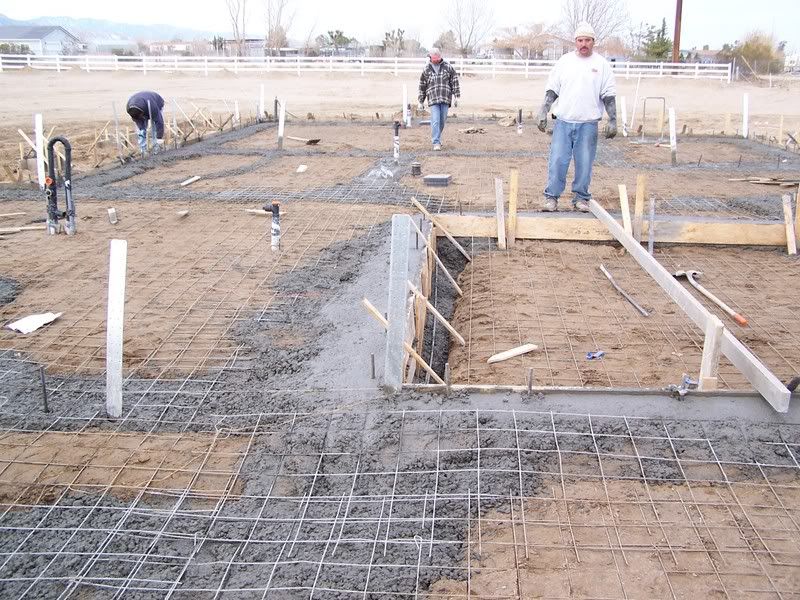You are using an out of date browser. It may not display this or other websites correctly.
You should upgrade or use an alternative browser.
You should upgrade or use an alternative browser.
building a new house
- Thread starter socallly
- Start date
- Views: 19330
/ building a new house
#41
EddieWalker
Epic Contributor
From what I can see in the pictures, it looks like your crew did a really nice job for you!!!
The floor plan looks interesting too. What's the space behind the garage, and along the walkway to the garage? I was thinking it's either a covered entry to a mud room where you can come in dirty and not mess up the house, or a covered area to store things, but have them out and handy.
I'm also curious about the expansion joints in your garage. Are you enclosing it? If it's exposed to the elements, the concrete will move and need the joints, but if it's enclosed, it's not very likely to move. Just like your living area.
I understand if you don't want to say, but I am curious what concrete is going for in your area, and also what the price per foot was for the crew?
Thanks,
Eddie
The floor plan looks interesting too. What's the space behind the garage, and along the walkway to the garage? I was thinking it's either a covered entry to a mud room where you can come in dirty and not mess up the house, or a covered area to store things, but have them out and handy.
I'm also curious about the expansion joints in your garage. Are you enclosing it? If it's exposed to the elements, the concrete will move and need the joints, but if it's enclosed, it's not very likely to move. Just like your living area.
I understand if you don't want to say, but I am curious what concrete is going for in your area, and also what the price per foot was for the crew?
Thanks,
Eddie
Eddie the space behind the garage is a small sunken living room and to the left of that is the hallway and laundry room and half bath.The garage will be your normal 2car,and the concrete was $90 a yard and the crew was $250x5people=$1250EddieWalker said:From what I can see in the pictures, it looks like your crew did a really nice job for you!!!
The floor plan looks interesting too. What's the space behind the garage, and along the walkway to the garage? I was thinking it's either a covered entry to a mud room where you can come in dirty and not mess up the house, or a covered area to store things, but have them out and handy.
I'm also curious about the expansion joints in your garage. Are you enclosing it? If it's exposed to the elements, the concrete will move and need the joints, but if it's enclosed, it's not very likely to move. Just like your living area.
I understand if you don't want to say, but I am curious what concrete is going for in your area, and also what the price per foot was for the crew?
Thanks,
Eddie
Hello everybody, Well I just wanted to update you guy's.I had some problems with missing hardware in the slab and I forgot to form up a little popout for a window.Now that's done so we got some framing done today

 That sunken floor is another nightmare the guy that helped form it made it to long so now the hallway behind it is 3ft wide it should be 4ft.You can also see where I will need to patch the concrete under that treated 2x4 .
That sunken floor is another nightmare the guy that helped form it made it to long so now the hallway behind it is 3ft wide it should be 4ft.You can also see where I will need to patch the concrete under that treated 2x4 .







 WE got the wall done they go up in the morning,trusses will be there on wednesday and hopefully sheeting the roof next saturday
WE got the wall done they go up in the morning,trusses will be there on wednesday and hopefully sheeting the roof next saturday
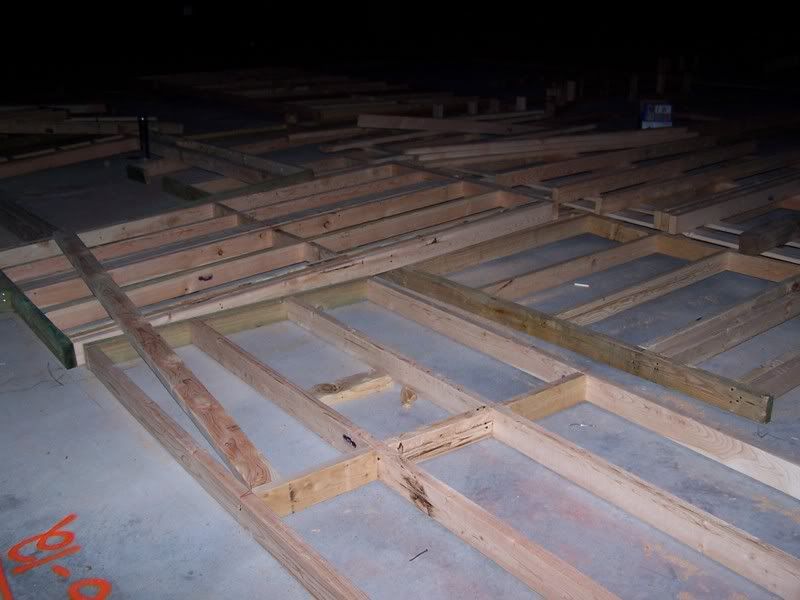















Last edited:
EddieWalker
Epic Contributor
Looks good. Everything your contractor has done looks first class. I haven't seen straps going into the foundation since I was in California. Do you have to tie them into your trusses? We had to in my area for earthquakes.
Did you put down a terminte shield or seal under the sill plates? I've found that adding both really makes a huge difference on just keeping ants out!! Not to mention everything else. hahaha
Eddie
Did you put down a terminte shield or seal under the sill plates? I've found that adding both really makes a huge difference on just keeping ants out!! Not to mention everything else. hahaha
Eddie
Eddie I dont need to tie the straps in.I sprayed the pad for termites before I poured but if I should do more please give me details....ThanksEddieWalker said:Looks good. Everything your contractor has done looks first class. I haven't seen straps going into the foundation since I was in California. Do you have to tie them into your trusses? We had to in my area for earthquakes.
Did you put down a terminte shield or seal under the sill plates? I've found that adding both really makes a huge difference on just keeping ants out!! Not to mention everything else. hahaha
Eddie
EddieWalker
Epic Contributor
You spray the pad before you build to kill them off. It's good for a few years, but in time, they will come back. I don't know how bad they are there, but here they are terrible. My understanding is that desert, dry climates don't have very many termites. In fact, I'm suprised that you had to spray the pad for them.
You can do a google search for termite shields, but basically they are just thin metal flashing that goes under the sill plate and overhangs over the sides of the foundation. Termites can build there tunnels straight up, but run into trouble going upside down. The termite shield stops them from getting past the concrete.
Of course, I don't know how you are finishing your exterior walls. If it's brick or masonary, than you don't do this. If you are putting on wood, cement, vinyl or lap siding, than it's a good idea if you have termites. It really depends on how bad they are and how much attention you pay to your foundation.
Termites need to build tunnels to leave the ground. They cannot survive exposed to the elements. There tunnels look like dirt pencils that come up from the ground to a place they can get into the house.
Eddie
You can do a google search for termite shields, but basically they are just thin metal flashing that goes under the sill plate and overhangs over the sides of the foundation. Termites can build there tunnels straight up, but run into trouble going upside down. The termite shield stops them from getting past the concrete.
Of course, I don't know how you are finishing your exterior walls. If it's brick or masonary, than you don't do this. If you are putting on wood, cement, vinyl or lap siding, than it's a good idea if you have termites. It really depends on how bad they are and how much attention you pay to your foundation.
Termites need to build tunnels to leave the ground. They cannot survive exposed to the elements. There tunnels look like dirt pencils that come up from the ground to a place they can get into the house.
Eddie
_RaT_
Super Member
- Joined
- Apr 19, 2000
- Messages
- 5,813
- Location
- Peoples Republic of Northern CA.
- Tractor
- Kioti 3510-SE HST
socallly said:Eddie I dont need to tie the straps in.I sprayed the pad for termites before I poured but if I should do more please give me details....Thanks
I like the way you did the garage with no stem walls. I take it there is no slope in the garage other then what we see at the entrance? I see your Simpson Strong wall at the garage goor openings that will get hold downs. I am getting ready to build a new garage myself.
The primer for PVC is a bit of a misunderstood part of the process. It does not prime the PVC like you think of paint primer, it actually cleans off oxidized PVC and softens the surface. If you read the instructions on the primer can, it mentions that if you cannot scratch off a very thin layer of PVC once you apply the primer, prime it again. The primer should be "scrubbed" on not just applied. Run the dauber around the pipe as necessary to thouroughly clean and etch the pipe. You also need to apply the glue to the primer in a short period of time or you need to re-soften the surface again with more primer. The color of the glue typically indicates whether it is a heavy bodied glue (grey) which is good for up to 12" PVC, clear, a medium bodied glue, or blue which is typically medium bodied but faster cure time. The cure time is dependent on the pipe size, the temp/humidity and the volatility of the PVC glue. I prefer grey and clear. In cooler whether, blue works very well. When it gets hot, go with grey or clear. When gluing up electrical conduit, do not put glue on the female fittings, it can cut wire and/or hang up the mouse used to pull string in the conduit. I use primer on older, oxidized conduit. If its very new and clean with no UV exposure, I do not.
I look forward to more pictures. I still enjoy going to building sites to see whats going on. There is some very creative stuff going on out there.
PS, use the radiant barrier plywood/OSB on the roof, it is amazing. The cost will quickly be recovered. Mark
yes I will be using tech shield osb $300 more but well worth it_RaT_ said:I like the way you did the garage with no stem walls. I take it there is no slope in the garage other then what we see at the entrance? I see your Simpson Strong wall at the garage goor openings that will get hold downs. I am getting ready to build a new garage myself.
The primer for PVC is a bit of a misunderstood part of the process. It does not prime the PVC like you think of paint primer, it actually cleans off oxidized PVC and softens the surface. If you read the instructions on the primer can, it mentions that if you cannot scratch off a very thin layer of PVC once you apply the primer, prime it again. The primer should be "scrubbed" on not just applied. Run the dauber around the pipe as necessary to thouroughly clean and etch the pipe. You also need to apply the glue to the primer in a short period of time or you need to re-soften the surface again with more primer. The color of the glue typically indicates whether it is a heavy bodied glue (grey) which is good for up to 12" PVC, clear, a medium bodied glue, or blue which is typically medium bodied but faster cure time. The cure time is dependent on the pipe size, the temp/humidity and the volatility of the PVC glue. I prefer grey and clear. In cooler whether, blue works very well. When it gets hot, go with grey or clear. When gluing up electrical conduit, do not put glue on the female fittings, it can cut wire and/or hang up the mouse used to pull string in the conduit. I use primer on older, oxidized conduit. If its very new and clean with no UV exposure, I do not.
I look forward to more pictures. I still enjoy going to building sites to see whats going on. There is some very creative stuff going on out there.
PS, use the radiant barrier plywood/OSB on the roof, it is amazing. The cost will quickly be recovered. Mark
Hello again,What a day,perfect weather,and a beautiful sky to stare at.I can't begin to tell you how greatful I am for my friend and his crew to come out on the weekend and get it done.These guys have done so much so fast I fill happy with the work done so far.Well we got the walls done today,shear panel tomorrow,trusses sooon>>>>

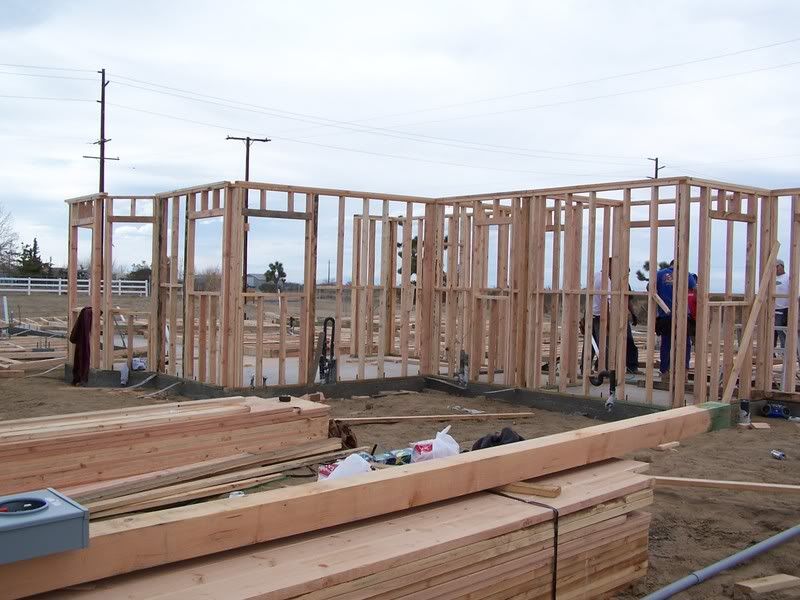
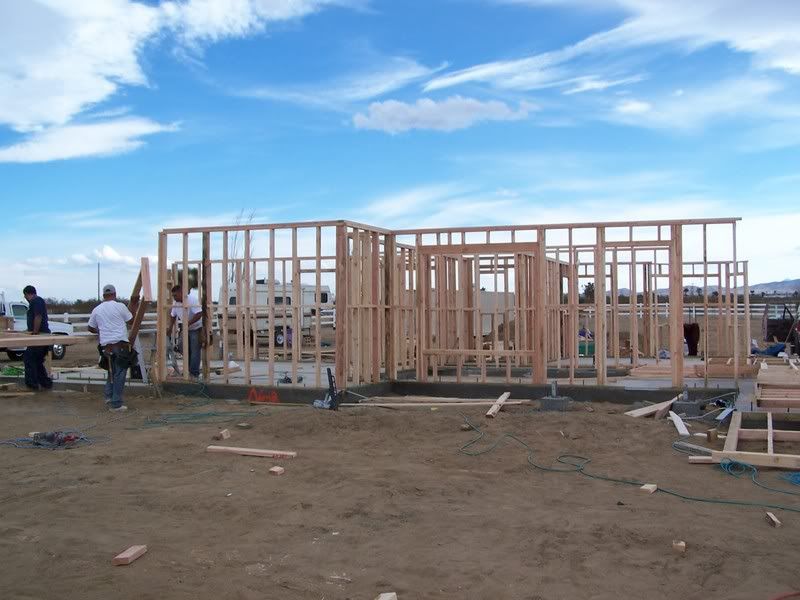





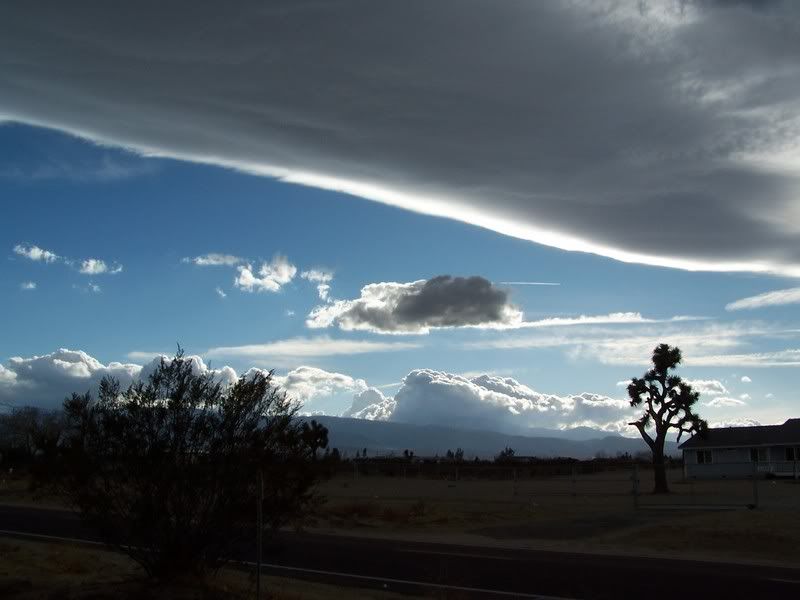









Last edited:

